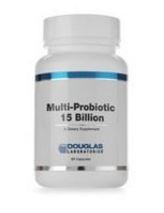Probiotics and Weight Loss: How Digestive Baceria Can Actually Help People Lose Weight
By: Pamela Egan, NP-C, CDE, ABAAHP
When supplement marketers attempt to explain to the public the value of probiotics, the discussion typically centers around the fact that probiotics can help to establish a regular pattern of bowel movements, helping to relieve diarrhea, curb constipation and establish a happy medium that constitutes something of a middle-ground – that point when bowel movements occur neither too frequently nor too infrequently, with the consistency being neither too hard nor too soft, minimizing the amount of discomfort one experiences in using the facilities.
Another benefit of probiotics, the good bacterial flora long associated with natural, unprocessed yogurt, with which the public is well familiar is the strengthened immune system that typically accompanies a healthy gut. However, a less noted side-effect of one’s digestive system functioning at peak performance is that a healthy gut can actually help one lose weight and keep off the pounds.
Antibiotics wipe out the good bacterial flora in the gut (intestinal tract) which slows down the metabolism, resulting in fewer calories burned relative to the amount of calories ingested. This results in unnatural weight gain.
In addition, the animals are fed estrogen supplements, which causes them to develop a condition known as estrogen dominance, which also brings about a hefty degree of unnatural weight gain. Hence, hormone balance is essential for weight loss, as is metabolic efficiency.
With regard to the latter, there is actually a quite simple solution for humans who have either been on antibiotics, ingested them indirectly via other food sources (such as beef) or for whatever other reason have an imbalance of intestinal flora inside the digestive tract. High-quality probiotics can actually help to restore the balance of what are often referred to as “good bacteria”. This helps aide digestion, which when combined with routine exercise and at least a somewhat healthy diet results in an enhanced rate-of-metabolism.
This enhanced metabolism typically helps bring about weight loss in overweight individuals provided the average amount of caloric intake were to remain constant from the time period prior to the balancing of intestinal flora to the point at which optimal bacterial flora levels are reached.
The math is really pretty simple: Calories, excess amounts of which are stored as fat, are ingested as food and calorie-containing beverages. Calories also power the human body (as well as all other animal life). The amount of calories stored as fat depends upon a couple of factors: 1) The amount of calories ingested; 2) The rate at which the calories are being burned as fuel; and 3) The amount of time unburned calories remain inside the body prior to being expelled in the form of waste (feces). By reducing the amount of time calories remain in the body from the time they are consumed to the time they are expelled, there is less time for them to be absorbed and stored in the form of fat.
The bottom line is that while probiotics are far from a miracle dietary supplement that will make you lose weight just by taking a little capsule, in conjunction with exercise, diet and hormonal balance, these healthy, all-natural bacteria can indeed help accelerate weight loss by regularing the digestive system, preventing constipation and helping one expel waste in a timely manner relative to the time-of-consumption.
The result is this: probiotics are not magic weight loss solution, but when implemented as part of a complete weight loss regimen that addresses all aspects of the metabolic cycle (caloric intake, rate-of-metabolism, hormonal balance and proper digestive function), can indeed help an overweight individual with poor digestive health lose weight and keep it off.
Related: Health Benefits of Probiotics

 The good news is that there is hope on the horizon. A recent study has shown that of all things the mineral zinc can help to reduce and prevent instances of infant diarrhea in the developing world. The occurrence of diarrhea in newborn babies and infants may be dramatically reduced when mothers take zinc supplements throughout the course of their pregnancy, according to a new study spearheaded by Dr. Laura E. Caulfield, of the Center for Human Nutrition, Department of International Health, Johns Hopkins Bloomberg School of Public Health in Baltimore.
The good news is that there is hope on the horizon. A recent study has shown that of all things the mineral zinc can help to reduce and prevent instances of infant diarrhea in the developing world. The occurrence of diarrhea in newborn babies and infants may be dramatically reduced when mothers take zinc supplements throughout the course of their pregnancy, according to a new study spearheaded by Dr. Laura E. Caulfield, of the Center for Human Nutrition, Department of International Health, Johns Hopkins Bloomberg School of Public Health in Baltimore.

